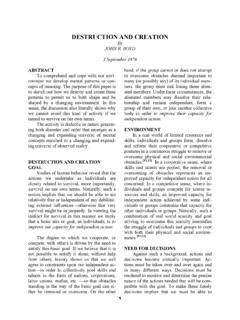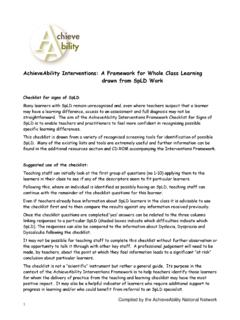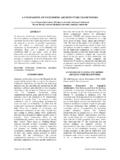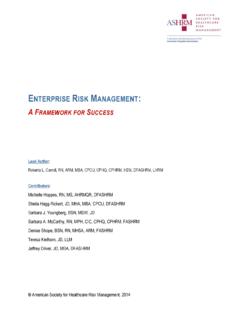Transcription of Goal Systems International
1 1 Goal Systems International Constructing and Communicating Common Sense 2011 Goal Systems International All rights reserved Systems Thinking and the Cynefin Framework A Strategic Approach to Managing Complex Systems by H. William Dettmer ABSTRACT The evolution of management over the past century, from Taylor and Fayol through Drucker and Deming, has been a process of continuing search, trial and error, deduction and induction, figuring out what works, what works better, and what doesn t work very well at all. There is no shortage of management methods and tools. However, the preponderance of these are tactical and quantitative.
2 Strategic, qualitative management aids are considerably fewer in number. Some methods and tools have realized significant successes in a variety of situations, while failing to meet expectations in others. Until now, there hasn t been an obvious underlying principle to explain why. Systems and their external environments can be classified as simple, complicated, complex, and chaotic. This taxonomy is known as the Cynefin Framework. It provides an orderly way to evaluate the interaction of organizational Systems , their external environments, and the myriad of management methods and tools available to decision makers. A significant number of or-ganizations today qualify as complex.
3 Their environment may change in short but irregular, un-predictable cycles, requiring the organization to adapt internally accordingly to avoid degrada-tion. But the majority of available management methods and tools have been designed to suc-ceed in simple and complicated domains, not complex. The failure to identify and understand the underlying assumptions about these methods made this limitation inevitable. That is about to change. A BRIEF HISTORY OF MANAGEMENT Many volumes have been written on the evolution of management over the last 125 years. It s not possible to recount all of that here, nor would doing so really advance the message of this paper.
4 But some foundation an anchor for the discussion that follows is required as a departure point for considering a new way of viewing management of Systems . Since the days of Frederick Taylor and Henri Fayol in the early 20th century, the evolution of management has been a continual search for a theory or set of prescriptions that could effec-tively guide leaders decision making in the widest possible variety of circumstances. The ob-jective of this search has proved elusive. In most cases, it produced discrete tools or methodolo-gies, usable in some circumstances though not in others, but not any kind of overarching frame-work that could be useful for the broadest population of organizational types: commercial, not-for-profit, and government agency.
5 Of Frederick Taylor, Peter Drucker, perhaps the most prominent management philosopher of the 20th century, said: [1] 2 Frederick W. Taylor was the first man in recorded history who deemed work deserving of sys-tematic observation and study. On Taylor's 'scientific management' rests, above all, the tre-mendous surge of affluence in the last seventy-five years which has lifted the working masses in the developed countries well above any level recorded before, even for the well-to-do. Tay-lor, though the Isaac Newton (or perhaps the Archimedes) of the science of work, laid only first foundations, however. Not much has been added to them since even though he has been dead all of sixty years.
6 [Emphasis added] Drucker wrote this in 1973. Since then the increase in management methodologies has been almost exponential. Fayol s contributions were perhaps even more important to modern management. His functions and principles of management (Figure 1), first advanced in 1917, formed the basis for modern management thinking that persists to this day. [4] In the second half of the 20th century, Fayol s original functions were simplified to five: [5] Planning Organizing Staffing Directing (or leading) Controlling These are the basic things that all people with executive re-sponsibility try to do well in order to succeed in their chosen envi-ronment.
7 Both Taylor and Fayol sought to make the management of organizations more regi-mented, more standardized and repetitive, under the assumption that operations would be more consistent, effective, and controllable. Ultimately, such controllability was expected to produce better overall results. From the perspective of the 21st century, the organizational Systems Taylor and Fayol sought to regulate seem relatively simple, and largely linear. Even up to the mid-20th century, organizational Systems remained fairly simple, or at most complicated, with a lot of compo-nents, but still relatively linear. Consequently, the standardization and regimentation that Taylor and Fayol sought to realize was relatively effective for the first half of the 20th century.
8 Vertical and Horizontal Integration Throughout the first half of the 20th century, many of the largest companies in America were vertically integrated. [6] In other words, the same company controlled all elements of the supply chain, from raw material production through finished product distribution and sales. A good example of a vertically integrated company was Ford Motors. Ford owned the iron mines in the Mesabi Range of northern Minnesota and the rubber plantations of South America. Iron ore was shipped on Ford-owned and operated boats to Detroit, where it was delivered to Ford s River Rouge steel mill for smelting.
9 The mill was adjacent to Ford s assembly plant. Rubber came by Ford-owned ships from South America to Ford s tire plants. All the components of Ford automobiles were produced by the company itself. Then the finished automobiles were shipped by Ford s transporters to Ford-controlled dealerships. Vertical integration provided cor-Figure 1. Fayol s Functions and Principles Goal Systems International Constructing and Communicating Common Sense 2011 Goal Systems International All rights reserved 3 porate executives what they craved most: control. Vertically integrated companies may have been complicated and not terribly efficient, but from beginning to end they were firmly under the executive s control.
10 Horizontal integration, by comparison, is a strategy of market control in which a company acquires, or merges with, like businesses (perhaps even competitors) to expand its presence or control in other geographic or market segments. [7] For example, Delta Airlines merger with Northwest Airlines in 2008 expanded Delta s reach into routes and markets it had previously not enjoyed. [8] But Delta is still not vertically integrated it doesn t control its own fuel sup-plies, or the manufacture of its airplanes, or even all of the booking of its passengers. Through World War II, most major companies were vertically integrated.









